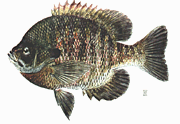|
"Your gateway to
understanding |
Bluegill
click for full size
- Oneida Lake individuals may be as long as 10 inches, as heavy as 0.5 pounds, and be more than 10 years old
- Eat insects & crustaceans, but will eat plant material as well
- Males may disguise themselves as females in order to fertilize other nests
Bluegills have a green to brown back that fades into brown, orange, or pink on their sides, and they have vertical bars that may be seen near the belly. The breast is yellow to copper-orange, and the sides of the head have hints of metallic blue and green (which gives this fish its name). The large, square-shaped, blue-black gill flap and obvious dark blotch at the back of the dorsal fin distinguishes bluegills from their close relative, the pumpkinseed.
Bluegills live in slow moving or standing water where there is plenty of vegetation or other shelter. Like other sunfish, the bluegill eats mostly insects and crustaceans, and in Oneida Lake, bluegills eat amphipods, scuds, zooplankton, and insects. However, the bluegill sets itself apart from other sunfish by its willingness to consume plant material. Bluegills are often found in schools of 20-30 individuals, and primarily feed in the morning and afternoon.
Bluegills spawn from May to July. Nests are built close to shore in firm sand or mud that is roughly 0.75 meters (2.5ft) deep. Bluegills tend to nest in colonies, and nests may be built right next to each other. During spawning, a male’s color generally becomes bolder and more aggressive to ward off intruders. Some small males mature early and adopt “female” colors in order to sneak into nests and fertilize eggs guarded by larger males. Male bluegills can raise two or three broods (all eggs from one nest at one time) during a single spawning season.
Bluegills fight hard when hooked and provide good sport for anglers. This sport-fish quality combined with being easy to catch has lead to frequent stocking in farm ponds and other recreational waters. Bluegill can now be found throughout North America, and have been introduced through Europe and South Africa as well.
To learn more about Bluegill ...
Bluegill Factsheet (pdf - 112kb)
![]() Oneida Lake Education Initiative Fish Homepage
Oneida Lake Education Initiative Fish Homepage

